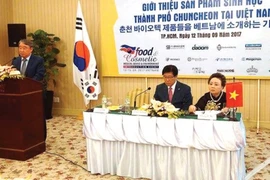 In addition to offering incentives to foreign cosmetics firms, Vietnam should come up with measures to encourage the growth of local beauty products, experts recommend. (Photo: sggp.org.vn)
In addition to offering incentives to foreign cosmetics firms, Vietnam should come up with measures to encourage the growth of local beauty products, experts recommend. (Photo: sggp.org.vn)HCM City (VNA) –Vietnamneeds more preferential policies to attract investors to the local cosmeticssector, economic experts have recommended.
According to the Vietnam Association of Essential Oils, Aromatherapy andCosmetics, import and export turnover of cosmetics products surged from 3billion USD in 2016 to 6 billion USD in 2017.
Due to the various materials that Vietnam can offer to produce cosmetics, thecountry has become a potential hub for foreign manufacturers.
Claudia Bonfiglioli, CEO of Information Beauty, said that sales generated fromworldwide organic beauty products were 480 million USD last year, up 10 percentyear-on-year.
The organic cosmetics sector is expected to double in value this year, shesaid, adding that this has encouraged multiple cosmetics manufactures to switchto organic products.
Vietnam is among a number of countries able to offer organic materials withhigh-added value such as coconut, mu trom (sterculia foetida),turmeric and aloe vera at affordable prices.
In addition to its powerful labour force, Vietnam has a large market ready tobuy organic beauty products.
Of nearly 100 million people, 60 percent of the population is under 35 yearsold, according to the Nielsen Company.
Vietnam’s average per capita income has risen to 53.5 million VND per year inrecent years, the company said.
Bart Verheyen, director of Medicare’s commercial affairs, said that within sixyears, Medicare had opened 65 stores in Vietnam with a focus on beauty andhealth products. Medicare plans to double its number of stores in the years tocome.
While organic beauty products are expected to be on-trend, imported cosmeticswill be preferred to local ones, he added.
Local beauty companies are encountering many challenges, given the significantgrowth of the imported beauty sector and expansion of cosmetics distributionsystems by foreign firms.
According to Director of the Vietnam Association of Essential Oils,Aromatherapy and Cosmetics Nguyen Van Minh, of the 6 billion USD of totalexport/import turnover in the cosmetics sector, only 5 percent isgenerated from sales of local beauty products.
Though turmeric, aloe vera and other materials are considered precious,domestic firms have sold them in raw form only and neglected extraction oftheir essence for production of higher-end products.
Thorakao and Miss Sai Gon are among a few local brands that still have a sharein the market, although it is modest.
Limited capital investment presents another challenge for domestic companies toexpand their scale of production and incorporate modern technologies in theirproduction chains.
This challenge, however, cannot be overcome in the short term, Minh said.
The association has sought approval from authorities to establish a researchcentre that maximises the use of existing materials and assists in effectivemanufacture of local cosmetics products.
However, the proposal has not received any feedback.
On a different note, the local authority’s failure to effectively monitoroperations of unlicensed firms and seize their counterfeit cosmetics hasgreatly affected consumers’ trust in local products.
According to economic experts, Vietnam should come up with measures to not onlyattract investment from foreign cosmetics firms but encourage growth of localbeauty products.
New local beauty products should be introduced, while the establishment of a researchcentre should be considered to bring the best out of the abundant raw materialsfor cosmetics production in the country, they said.
Cosmetics firms should also keep up with new trends in organic products toefficiently produce and distribute products widely embraced by consumers.-VNA


























